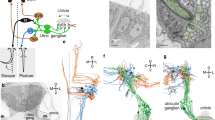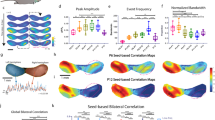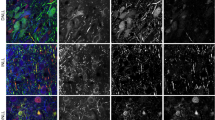Abstract
The development of the nervous system includes the formation of specific neuronal connections. Some insight into the mechanisms by which these connections are made may be obtained by determining the order in which the elements of a developing system begin to function and examining any changes that may occur in the system shortly after it begins functioning. I have investigated the lateral line of the South African clawed frog, Xenopus laevis and I have classified the afferent system into three elements. First, the transduction mechanism, which includes all components that couple the water vibrations to the release of transminer from the hair cell. Second, the afferent synapse, at which there is transmitter release and subsequent postsynaptic conductance changes. And third, the afferent axon. I report here experiments suggesting that these elements become functional in the following order: first, the axon can conduct action potentials; second, transmission is established; third, the transduction mechanism can modulate transmitter release. This same sequence has been reported in a system related to the lateral line, the auditory pathway of mammals1.
This is a preview of subscription content, access via your institution
Access options
Subscribe to this journal
Receive 51 print issues and online access
$199.00 per year
only $3.90 per issue
Buy this article
- Purchase on Springer Link
- Instant access to full article PDF
Prices may be subject to local taxes which are calculated during checkout
Similar content being viewed by others
References
Pujol, R. & Hilding, D. Acta otolar. 76, 1–10 (1973).
Harris, G. G. & Flock, A. in Lateral Line Detectors (ed. P. Cahn) 135–161 (Indiana University Press, Bloomington, 1967).
Gorner, P. in Lateral Line Detectors (ed. P. Cahn) 199–214 (Indiana University Press, Bloomington, 1967).
Nieuwkoop, P. D. & Faber, J. Normal Table of Xenopus laevis (North Holland, Amsterdam, 1956).
Shelton, P. M. J. exp. Zool. 178, 211–232 (1971).
Steinbach, A. B. & Bennett, M. V. L. J. gen. Physiol. 58, 580–598 (1971).
Flock, A. & Lam, D. M. K. Nature 249, 142–144 (1974).
Katz, B. & Thesleff, S. J. Physiol., Land. 138, 63–80 (1957).
Dudel, J. Pflugers Arch, ges Physiol. 356, 317–327 (1975).
Russell, I. J. J. exp. Biol 54, 634–658 (1971).
Roberts, A. Nature 273, 774–775 (1978).
Gaze, R. M., Keating, M. J. & Chung, S. H. Proc. R. Soc. B185, 301–330 (1974).
Author information
Authors and Affiliations
Rights and permissions
About this article
Cite this article
Zimmerman, D. Onset of neural function in the lateral line. Nature 282, 82–84 (1979). https://doi.org/10.1038/282082a0
Received:
Accepted:
Issue Date:
DOI: https://doi.org/10.1038/282082a0
Comments
By submitting a comment you agree to abide by our Terms and Community Guidelines. If you find something abusive or that does not comply with our terms or guidelines please flag it as inappropriate.



